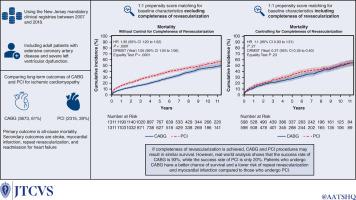当前位置:
X-MOL 学术
›
J. Thorac. Cardiovasc. Surg.
›
论文详情
Our official English website, www.x-mol.net, welcomes your feedback! (Note: you will need to create a separate account there.)
Choice of revascularization strategy for ischemic cardiomyopathy due to multivessel coronary disease
The Journal of Thoracic and Cardiovascular Surgery ( IF 6 ) Pub Date : 2024-03-15 , DOI: 10.1016/j.jtcvs.2024.03.007 Anas H. Alzahrani , Shinobu Itagaki , Natalia Egorova , Joanna Chikwe
The Journal of Thoracic and Cardiovascular Surgery ( IF 6 ) Pub Date : 2024-03-15 , DOI: 10.1016/j.jtcvs.2024.03.007 Anas H. Alzahrani , Shinobu Itagaki , Natalia Egorova , Joanna Chikwe

|
Limited comparative data guide the decision between coronary artery bypass grafting and percutaneous coronary intervention for multivessel revascularization in ischemic cardiomyopathy. The study objective was to compare the long-term outcomes of coronary artery bypass grafting and percutaneous coronary intervention for ischemic cardiomyopathy. Clinical registries from the New Jersey Department of Health linked to administrative databases were used to compare all-cause mortality, repeat revascularization, heart failure readmissions, myocardial infarction, and stroke using Cox proportional hazards and propensity matching with competing risk analysis in 5988 patients with ejection fraction 35% or less who underwent coronary artery bypass grafting (3673, 61.3%) or percutaneous coronary intervention (2315, 38.6%) for multivessel coronary disease between 2007 and 2018. Median follow-up time was 5.2 years (range, 0-13 years); the last follow-up date was December 31, 2020. After controlling for completeness of revascularization, at 13 years, mortality was 57% (95% CI, 51-63) after percutaneous coronary intervention and 60% (95% CI, 53-66) after coronary artery bypass grafting (hazard ratio [HR], 1.10; 95% CI, 0.93-1.31; = .28); risk of repeat revascularization was 18% for percutaneous coronary intervention versus 14% for coronary artery bypass grafting (HR, 1.62; 95% CI, 1.17-2.25; = .003); risk of readmission for heart failure was 16% after percutaneous coronary intervention and coronary artery bypass grafting (HR, 1.13,95% CI, 0.84-1.51, weighted = .10); risk of myocardial infarction was 10% versus 6%, respectively (HR, 1.91; 95% CI, 1.18-3.09; = .007); and stroke risk was 3% versus 4%, respectively (HR, 0.79; 95% CI, 0.41-1.53; = .52). Rate of complete revascularization was lower after percutaneous coronary intervention than after coronary artery bypass grafting and associated with higher mortality after percutaneous coronary intervention (HR, 1.35; 95% CI, 1.20-1.52; < .001). Coronary bypass was associated with similar mortality, stroke, and heart failure readmissions, and reduced repeat revascularization compared with percutaneous coronary intervention in patients with ischemic cardiomyopathy if similar rates of complete revascularization were achieved. These findings support consensus recommendations for coronary artery bypass grafting and medical therapy in patients with multivessel coronary disease and left ventricular dysfunction.
中文翻译:

多支冠状动脉疾病所致缺血性心肌病血运重建策略的选择
有限的比较数据指导冠状动脉旁路移植术和经皮冠状动脉介入治疗缺血性心肌病多支血管血运重建之间的决定。该研究的目的是比较冠状动脉旁路移植术和经皮冠状动脉介入治疗缺血性心肌病的长期结果。新泽西州卫生部的临床登记与管理数据库相连接,使用 Cox 比例风险和倾向匹配与竞争风险分析对 5988 名射血患者进行比较全因死亡率、重复血运重建、心力衰竭再入院、心肌梗死和中风2007 年至 2018 年间,因多支冠状动脉疾病接受冠状动脉旁路移植术(3673 例,61.3%)或经皮冠状动脉介入治疗(2315 例,38.6%)的比例为 35% 或更少。中位随访时间为 5.2 年(范围:0-13 年)年);最后一次随访日期为 2020 年 12 月 31 日。在控制血运重建的完整性后,13 年时,经皮冠状动脉介入治疗后死亡率为 57% (95% CI, 51-63),死亡率为 60% (95% CI, 53-63)。 66) 冠状动脉旁路移植术后(风险比 [HR],1.10;95% CI,0.93-1.31;= .28);经皮冠状动脉介入治疗的再次血运重建风险为 18%,而冠状动脉旁路移植术的风险为 14%(HR,1.62;95% CI,1.17-2.25;= .003);经皮冠状动脉介入治疗和冠状动脉旁路移植术后,因心力衰竭再入院的风险为 16%(HR,1.13,95% CI,0.84-1.51,加权 = 0.10);心肌梗塞的风险分别为 10% 和 6%(HR,1.91;95% CI,1.18-3.09;= .007);中风风险分别为 3% 和 4%(HR,0.79;95% CI,0.41-1.53;= .52)。经皮冠状动脉介入治疗后的完全血运重建率低于冠状动脉旁路移植术后,且与经皮冠状动脉介入治疗后较高的死亡率相关(HR,1.35;95% CI,1.20-1.52;< .001)。与缺血性心肌病患者经皮冠状动脉介入治疗相比,如果达到相似的完全血运重建率,冠状动脉搭桥术与相似的死亡率、卒中和心力衰竭再入院相关,并且可以减少重复血运重建。这些发现支持对多支冠状动脉疾病和左心室功能障碍患者进行冠状动脉旁路移植和药物治疗的共识建议。
更新日期:2024-03-15
中文翻译:

多支冠状动脉疾病所致缺血性心肌病血运重建策略的选择
有限的比较数据指导冠状动脉旁路移植术和经皮冠状动脉介入治疗缺血性心肌病多支血管血运重建之间的决定。该研究的目的是比较冠状动脉旁路移植术和经皮冠状动脉介入治疗缺血性心肌病的长期结果。新泽西州卫生部的临床登记与管理数据库相连接,使用 Cox 比例风险和倾向匹配与竞争风险分析对 5988 名射血患者进行比较全因死亡率、重复血运重建、心力衰竭再入院、心肌梗死和中风2007 年至 2018 年间,因多支冠状动脉疾病接受冠状动脉旁路移植术(3673 例,61.3%)或经皮冠状动脉介入治疗(2315 例,38.6%)的比例为 35% 或更少。中位随访时间为 5.2 年(范围:0-13 年)年);最后一次随访日期为 2020 年 12 月 31 日。在控制血运重建的完整性后,13 年时,经皮冠状动脉介入治疗后死亡率为 57% (95% CI, 51-63),死亡率为 60% (95% CI, 53-63)。 66) 冠状动脉旁路移植术后(风险比 [HR],1.10;95% CI,0.93-1.31;= .28);经皮冠状动脉介入治疗的再次血运重建风险为 18%,而冠状动脉旁路移植术的风险为 14%(HR,1.62;95% CI,1.17-2.25;= .003);经皮冠状动脉介入治疗和冠状动脉旁路移植术后,因心力衰竭再入院的风险为 16%(HR,1.13,95% CI,0.84-1.51,加权 = 0.10);心肌梗塞的风险分别为 10% 和 6%(HR,1.91;95% CI,1.18-3.09;= .007);中风风险分别为 3% 和 4%(HR,0.79;95% CI,0.41-1.53;= .52)。经皮冠状动脉介入治疗后的完全血运重建率低于冠状动脉旁路移植术后,且与经皮冠状动脉介入治疗后较高的死亡率相关(HR,1.35;95% CI,1.20-1.52;< .001)。与缺血性心肌病患者经皮冠状动脉介入治疗相比,如果达到相似的完全血运重建率,冠状动脉搭桥术与相似的死亡率、卒中和心力衰竭再入院相关,并且可以减少重复血运重建。这些发现支持对多支冠状动脉疾病和左心室功能障碍患者进行冠状动脉旁路移植和药物治疗的共识建议。



























 京公网安备 11010802027423号
京公网安备 11010802027423号